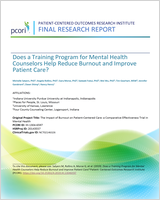From: Does a Training Program for Mental Health Counselors Help Reduce Burnout and Improve Patient Care?

Does a Training Program for Mental Health Counselors Help Reduce Burnout and Improve Patient Care? [Internet]
Salyers M, Rollins A, Morse G, et al.
Washington (DC): Patient-Centered Outcomes Research Institute (PCORI); 2019 Apr.
Copyright © 2019. Indiana University-Purdue University at Indianapolis. All Rights Reserved.
This book is distributed under the terms of the Creative Commons Attribution-NonCommercial-NoDerivs License which permits noncommercial use and distribution provided the original author(s) and source are credited. (See https://creativecommons.org/licenses/by-nc-nd/4.0/
NCBI Bookshelf. A service of the National Library of Medicine, National Institutes of Health.